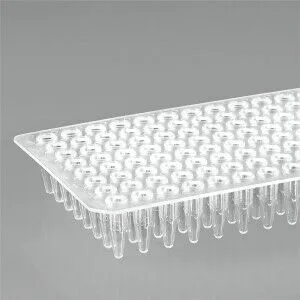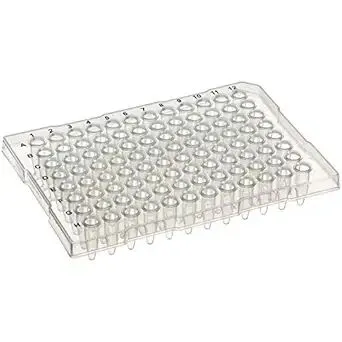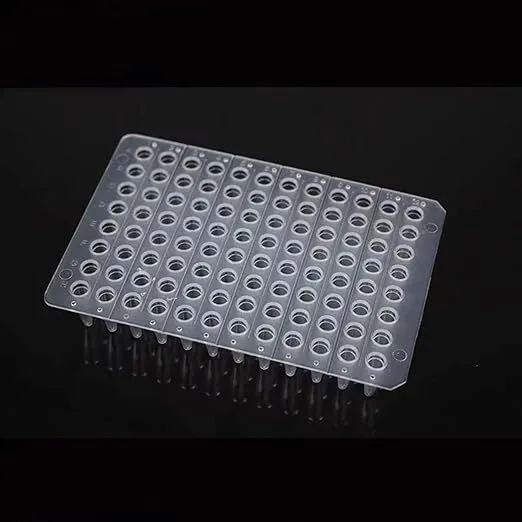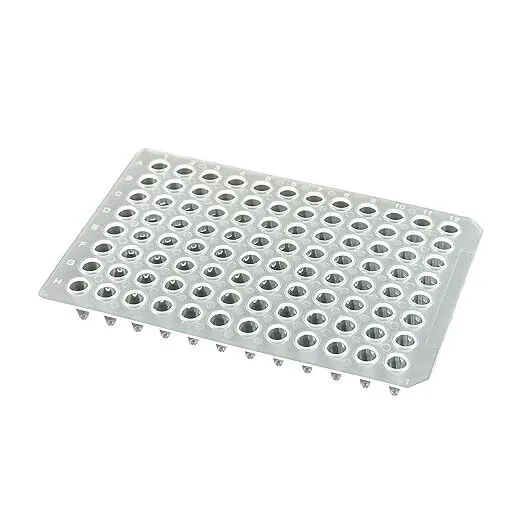PCR Plates
PCR plates, featuring ultra-thin walls and flat surfaces, play an important role in PCR experiments. With designs of full skirt, half skirt and no skirt, PCR plates can be better suitable for common PCR instruments and automation applications. Moreover, their raised rims and clear alphanumeric letterings make the sealing and data identification easier and quicker.
Total 12 Records
PP Plastic PCR Plates, 0.2 mL, Non-Skirted, Autoclavable
Category: PCR Plates
Model no.PSB-240717-PP-05
Request a quote
Half Skirted PCR Plates, 96-Well, 0.2 mL, Ultra-Clear, PP
Category: PCR Plates
Model no.PSB-240717-PP-04
Request a quote
0.2 mL PCR Plate, Semi-Skirted, Flat Rim, Ultra Clear, PP
Category: PCR Plates
Model no.PSB-240717-PP-03
Request a quote
PCR 96 Well Plate, No-Skirt, 0.2 mL, PP Plastic, Transparent
Category: PCR Plates
Model no.PSB-240717-PP-02
Request a quote
Non-Skirted PCR Plates, 96 Well, 0.1 mL, DNA/RNA Free, Clear
Category: PCR Plates
Model no.PSB-240717-PP-01
Request a quote
Half Skirted PCR Plate, Transparent, 0.1 mL, Polypropylene
Category: PCR Plates
Model no.PSB-240111-PP-02
Request a quote
PCR plates are primarily used as the primer in PCR amplification and the carrier of Taq DNA polymerase, dNTP, buffer solution, etc. As the disposable consumables in the laboratory, they are applied in basic research such as gene isolation, cloning and nucleic acid sequence analysis, and used in disease diagnosis or any other experiment related to DNA and RNA.
PCR plates we supply are reliable, and there are products of 0.1ml and 0.2ml volume customers can choose from. In order to improve the efficiency of PCR reaction and make sure the experiment runs stably and smoothly, uniform and ultra-thin PCR consumables are the best choices. Therefore, we adopt the thin-wall design, making the temperature control of the reaction solution in the tube quicker and more accurate. The low retention PCR plate also can achieve a better recovery effect with very few residual samples and reagents during processing. The edge of the hole has a raised design, preventing the cross-infection of liquid, increasing the sealing performance of the film and reducing the evaporation of samples. The horizontal and vertical directions of the plate are marked with alpha-numeric lettering, which is clear, easy to read and convenient for operation and identification.
Meanwhile, there are three different designs of PCR plates: no skirt, half skirt and full skirt. The skirt is to better adapt to the automation application and provide stable support and mechanical tolerance strength for the instrument, with the stability in the pipetting process being higher. Non-skirted plates are suitable for most PCR instruments rather than automation applications. And due to the low stability during pipetting, they need to work with PCR plate racks. Half-skirted plates offer good stability, and can be used with labels or bar codes and automation applications. And plates in full-skirted type are well-suited for automatic experiments with their high stability and good mechanical strength.
Features of PCR Plates:
· Medical grade polypropylene (PP) material, to ensure a low rate of liquid loss
· Thin-walled design, to effectively improve the thermal conductivity
· Be stable and not easy to deform
· No DNA enzyme, no RNA enzyme, no pyrogens
· Optimal design of the tube
· Raised edge, to avoid the cross-infection
· Suitable for most PCR instruments
· Marked with letters and numbers, to facilitate the identification and recording of samples
PCR plates we supply are reliable, and there are products of 0.1ml and 0.2ml volume customers can choose from. In order to improve the efficiency of PCR reaction and make sure the experiment runs stably and smoothly, uniform and ultra-thin PCR consumables are the best choices. Therefore, we adopt the thin-wall design, making the temperature control of the reaction solution in the tube quicker and more accurate. The low retention PCR plate also can achieve a better recovery effect with very few residual samples and reagents during processing. The edge of the hole has a raised design, preventing the cross-infection of liquid, increasing the sealing performance of the film and reducing the evaporation of samples. The horizontal and vertical directions of the plate are marked with alpha-numeric lettering, which is clear, easy to read and convenient for operation and identification.
Meanwhile, there are three different designs of PCR plates: no skirt, half skirt and full skirt. The skirt is to better adapt to the automation application and provide stable support and mechanical tolerance strength for the instrument, with the stability in the pipetting process being higher. Non-skirted plates are suitable for most PCR instruments rather than automation applications. And due to the low stability during pipetting, they need to work with PCR plate racks. Half-skirted plates offer good stability, and can be used with labels or bar codes and automation applications. And plates in full-skirted type are well-suited for automatic experiments with their high stability and good mechanical strength.
Features of PCR Plates:
· Medical grade polypropylene (PP) material, to ensure a low rate of liquid loss
· Thin-walled design, to effectively improve the thermal conductivity
· Be stable and not easy to deform
· No DNA enzyme, no RNA enzyme, no pyrogens
· Optimal design of the tube
· Raised edge, to avoid the cross-infection
· Suitable for most PCR instruments
· Marked with letters and numbers, to facilitate the identification and recording of samples





